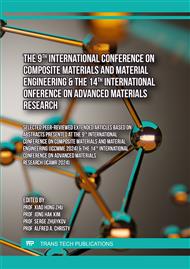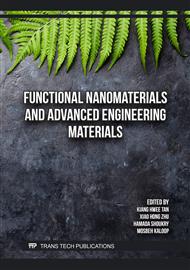p.59
p.75
p.83
p.89
p.95
p.101
p.109
p.119
p.125
Enhancing Dispersion Ability and Bond Strength of Boron Nitride with Epoxy Resin by Ar+ Ion Beam in Reactive Oxygen Gas Environment
Abstract:
Boron Nitride (BN) filler was modified by an ion beam surface treatment to enhance dispersibility to polar solvent and bond strength with epoxy. Surface treatment of the fillers was conducted by Ion Assisted Reaction (IAR), in which Ar+ ion beam is irradiated on the filler surface with energy of 1keV, dose varied from 1x1014 ~ 5x1016 Ar+ ions/cm2 by using Cold Hollow Cathode type ion source and oxygen gas 5-10ml/sec. After the surface treatment, the BN powder were spontaneously dispersed into polar solvent in a visual observation which means the modified surface was changed from hydrophobic to hydrophilic, and the powder were easily mixed with a viscous epoxy resin until 40wt% without thinner (a gelation phenomenon with easy blending into the epoxy resin), but the untreated powder exhibits difficulty in mixing with epoxy resin without the thinner. XPS analysis showed oxygen functional groups (B-ON, BN, etc.) were formed on the surface of BN. It was confirmed the surface modification has a high filling ability of the BN filler with binder and better adhesion with epoxy resin compared to the untreated BN filler.
Info:
Periodical:
Pages:
95-100
Citation:
Online since:
July 2024
Authors:
Keywords:
Price:
Сopyright:
© 2024 Trans Tech Publications Ltd. All Rights Reserved
Share:
Citation:



